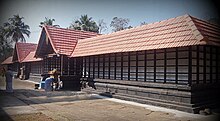Thumpamon Vadakkumnatha Temple
| Thumpamon Vadakkumnatha Temple | |
|---|---|

Thumpamon Vadakkumnatha Temple
|
|
| Geography | |
| Country | India |
| State | Kerala |
| District | Pathanamthitta |
| Location | Pandalam |
| Culture | |
| Sanctum | Shiva |
| Important festivals | Uthrada Maholsavam Maha Shivaratri |
| Architecture | |
| Architectural styles | Traditional Kerala style |
| History and governance | |
| Website | thumpamonvadakkumnathan |
Thumpamon Vadakkumnatha Temple is an ancient temple near Pandalam in Kerala, India. This temple has two Sreekovils (sanctum sanctorum). Both Sreekovils are round (vatta). It is an age old temple whispering several fascinating legendary fables of the bygone eras.
The first Sreekovil of this temple is dedicated to a deity named as Vadakkumnatha. It is believed by the worshippers that the Lord installed in this Sreekovil is a form of Lord Shiva. Few other devotees believe that the deity is a representation of Muruga, i.e. Lord Kartikeya, while others are of the opinion, that it is a form of Lord Vishnu. However, the deity resembles Sree Buddha.
The worshipers believe that the deity in the second Sreekovil (known as Thekkumnathan) is Balamuruga. It is believed that this deity was worshiped by Sakthibhadra the author of Acharya Chudamani (a drama for Koodiyatta). The Sreekovil has been adorned with magnificent mural paintings that augment its beauty. The important festivals that are celebrated in this temple include Uthrada Maholsavam (Thiruutsavam - yearly celebration) Sreemath Bhagavatha Sapthaham, Mahashivarathri, Thaipooyam, Vishu, Onam, etc. The Uthrada Maholsavam is celebrated in the Uthradam star of Malayalam month Meenam.
The general form of Thumpamon Sree Vadkkumnatha temple is based on the Pancha-Prakara Layout-scheme of the traditional Kerala temples. The Bhakti movement and resurgence of Hinduism also marked the revival of temple construction. According to Kularnava Tantra human body itself is a temple and Sadashiva or Paramathma is the deity in this temple. This Sidhantha (theory) is adopted in the construction of Kerala Temples. Sreekovil or Garbhagruham (sanctum sanctorum) is considered as the head of the deity, Antharalam or inner Balivattom is considered as the face, Mukhamandapam or Namaskara mandapam is considered as the neck, Nalambalam is considered as the hands, Pradakshinaveethi is considered as the Kukshi Pradesa (stomach), compound wall is considered as the legs and the main Gopuram is considered as the foot of the deity. That means Panchaprakaras (Prakaram or compound wall, Bahyahara or Sheevelippura, Madhyahara or Vilakkumadam, Anthahara or Nalambalam and Antharalam or inner Balivattom) of the temple is the Sthoola Sareera (visible part of the body) of the deity. The Deva Prathishta or idol inside the Sreekovil or Garbhagriha and the Shadaadharas (Aadharashila, Nidhikumbham, Padmam, Koormam, Yoganaalam and Napumsaka Shila) under the Prathishta is the Sookshma Sareera (soul) of the deity. The Dwajam (flag staff) or Kodimaram is the spinal code of the deity. Hence a typical Kerala temple resembles a human body in all aspects. Fully realising the need to create places of worship that would attract devotees, the Pancha-Prakara scheme became the standard for temple architecture. The dimensions of the five components of the temple architecture are laid out in Tantra Samucchaya, a treatise on temple architecture, compiled and written in ca. 1300 AD. The five (Pancha) enclosures (Prakaras) around the Sanctum of the Thumpamon Sree Vadkkumnatha temple is as follows:
...
Wikipedia
